Architecture is an ever-evolving field that mirrors advancements in technology and societal needs. Today’s buildings are not just places where people live or work; they are symbols of innovation, sustainability, and cutting-edge technology.
In this article, we explore five architectural masterpieces that embody the future by integrating advanced technologies, redefining modern architecture.
1. The Edge, Amsterdam, Netherlands
Hailed as the world’s smartest building, The Edge in Amsterdam sets a new standard for intelligent workplaces. This building seamlessly integrates technology to create an environment that maximizes efficiency, comfort, and sustainability.
The Edge is equipped with over 28,000 sensors distributed throughout the building and its surroundings. These sensors monitor various parameters such as:
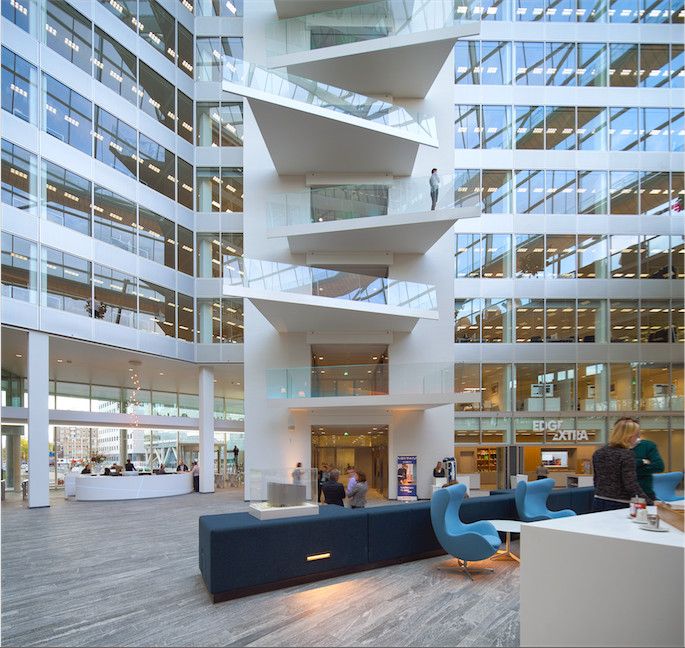
A. Space Occupancy: Tracking which areas are in use to optimize space utilization. B. Natural Light Exposure: Adjusting blinds and lighting to make the most of daylight. C. Temperature and Air Quality: Maintaining a comfortable and healthy indoor environment.
By collecting this data, the building’s management system can optimize climate control, lighting, and energy usage, ensuring that conditions are always comfortable and resources are used efficiently.
One of the standout features is that employees can personalize their workspace settings through a dedicated smartphone application. This app allows them to:
A. Adjust Lighting: Control the brightness and color temperature to suit their tasks. B. Regulate Temperature: Set their preferred climate conditions. C. Find Available Workspaces: Locate areas that match their preferences for noise level, light, and collaboration.
Erik Ubels, the Project Director of The Edge, emphasizes the building’s pioneering approach:
“Our experiment has shown that technology can make a workspace healthier and more productive. The Edge is designed to demonstrate this concept fully.”
Beyond comfort and efficiency, The Edge is also a paragon of sustainability. It uses energy-efficient systems, and its design maximizes natural light, reducing the need for artificial lighting during the day. The building’s facade incorporates photovoltaic panels that generate renewable energy, contributing to its status as one of the most sustainable office buildings in the world.
Furthermore, The Edge’s integration with technology extends to its facilities management. The data collected by the sensors helps in predictive maintenance, identifying potential issues before they become problems. This proactive approach not only reduces downtime but also extends the lifespan of the building’s systems.
2. The Oculus, New York City, United States
Located at the World Trade Center site, The Oculus is more than just a transportation hub; it’s a testament to modern design and technological innovation. Designed by architect Santiago Calatrava, The Oculus stands out with its futuristic appearance and high-tech features.
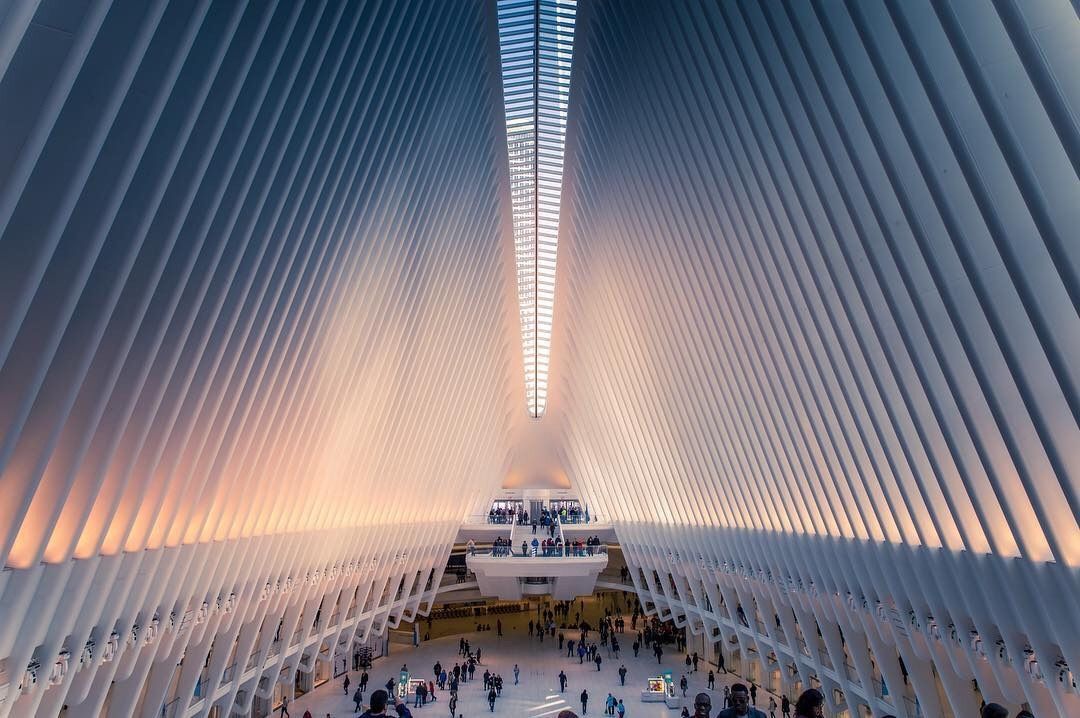
The building’s design resembles a bird taking flight, symbolizing hope and rebirth for the city. The interior boasts expansive glass walls that allow natural light to flood the space, creating a bright and uplifting environment for commuters and visitors alike.
An advanced lighting system enhances The Oculus’s ambiance, particularly at night. The system uses state-of-the-art LED technology to illuminate the structure in various colors and patterns, creating a dynamic and engaging visual experience.
Santiago Calatrava describes The Oculus as:
“A transportation hub that symbolizes New York City’s rebirth; it is a masterpiece that features the most creative lighting technology.”
In addition to its aesthetic appeal, The Oculus incorporates cutting-edge technology in its construction and operations. The building utilizes sustainable materials and energy-efficient systems, aligning with New York City’s commitment to environmental responsibility.
The integration of technology extends to the user experience as well. Digital kiosks and interactive displays provide real-time information about transit schedules, events, and amenities within the complex. The Oculus seamlessly blends art, architecture, and technology to create a space that is both functional and inspiring.
3. The Shard, London, England
Dominating the London skyline at 310 meters tall, The Shard is an iconic symbol of modern architecture and technological advancement. Designed by Renzo Piano, this skyscraper is not only remarkable for its height but also for the innovative technologies embedded within its structure.
One of the most notable features of The Shard is its facade, composed of over 11,000 pieces of glass. These reflective panels are angled in such a way that they capture and refract light, giving the building a shimmering appearance that changes with the weather and time of day. At night, the building becomes a beacon, illuminated by an intricate lighting system that enhances its presence in the cityscape.
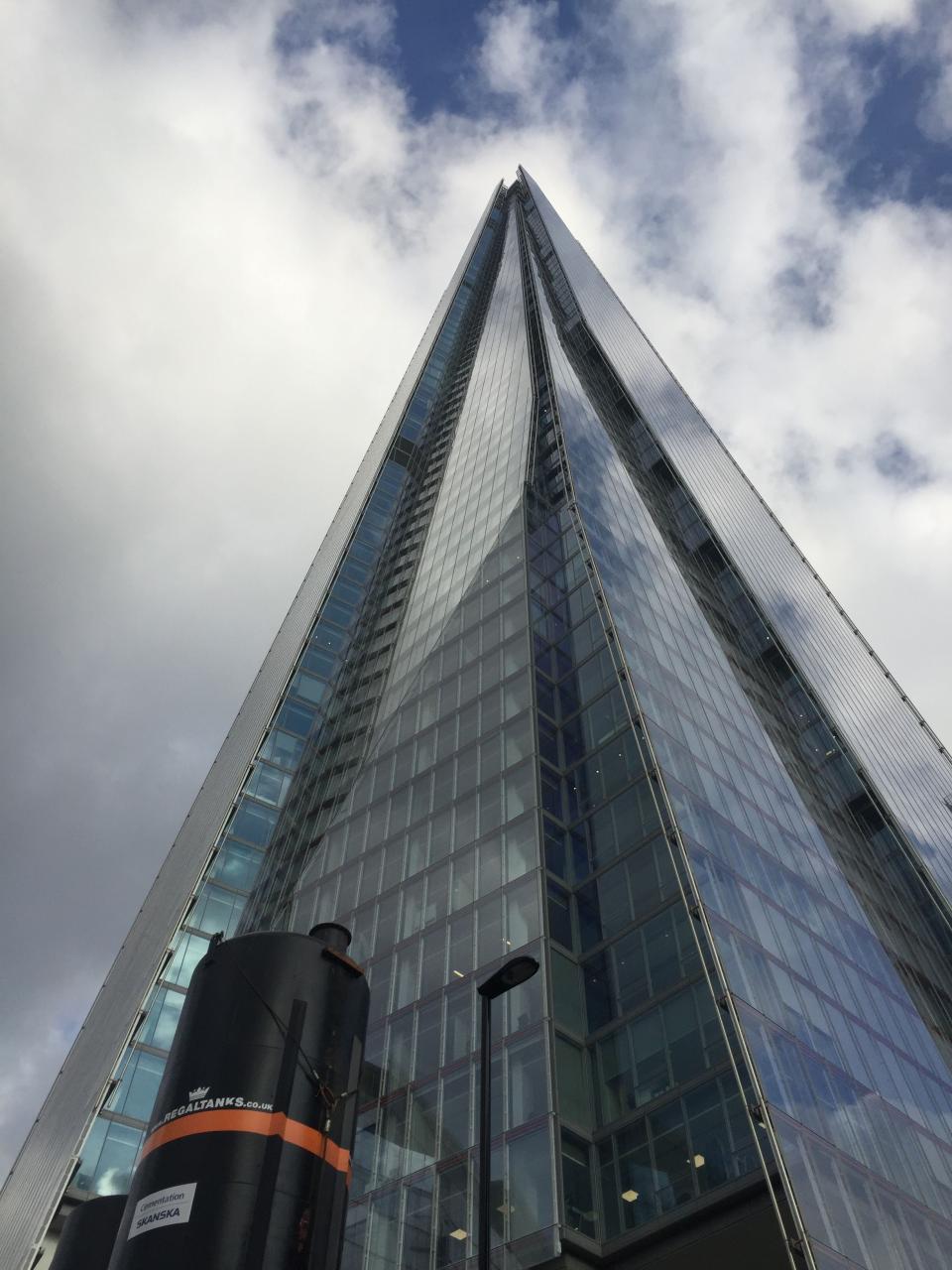
The Shard also boasts Europe’s fastest elevators, capable of transporting visitors from the ground floor to the viewing platform in just 45 seconds. These elevators are equipped with advanced technologies to ensure a smooth and safe ride, including real-time monitoring systems and energy-efficient motors.
Renzo Piano describes The Shard as:
“A new symbol; it is new and interesting, and has a contemporary architecture to it yet is within the possession of the modernity of today’s London.”
Sustainability is another key aspect of The Shard’s design. The building incorporates energy-efficient systems for heating, cooling, and lighting. It uses a combined heat and power plant that generates electricity on-site, reducing reliance on the grid and lowering carbon emissions.
Moreover, The Shard includes office spaces, residences, restaurants, and a hotel, making it a vertical city that maximizes land use in the densely populated urban environment. The integration of mixed-use spaces within the building showcases how technology and design can come together to create efficient and sustainable urban solutions.
4. The Interlace, Singapore
The Interlace is a groundbreaking residential complex in Singapore that challenges traditional notions of urban living. Designed by architect Ole Scheeren, this innovative development reimagines apartment living by stacking 31 apartment blocks in a hexagonal arrangement, creating a network of interconnected communal spaces.
The unique design of The Interlace allows for ample natural ventilation and light. The staggered arrangement of the blocks creates openings that enable fresh, cool air to circulate freely throughout the complex, reducing the need for artificial cooling and thereby lowering energy consumption.
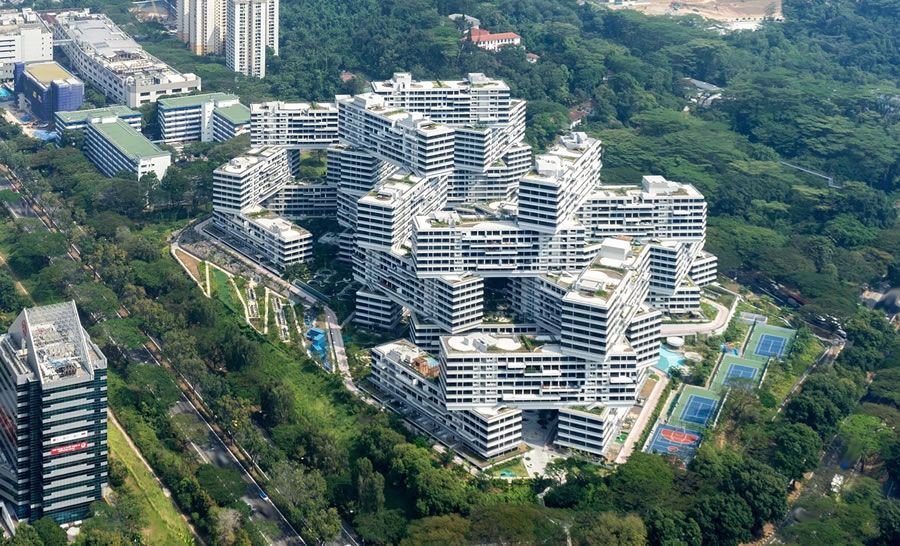
Each apartment comes with a spacious balcony that offers panoramic views of lush greenery. The incorporation of extensive landscaping and greenery throughout the complex not only enhances aesthetics but also contributes to a healthier living environment by improving air quality and providing residents with access to nature.
Ole Scheeren explains the vision behind The Interlace:
“We wanted to invent a building that is more in touch with its natural environment. The Interlace is such an experiment that has to change the future of urban environments.”
The complex includes a range of amenities designed to foster community interaction, such as:
A. Swimming Pools: Multiple pools for leisure and exercise. B. Playgrounds: Safe and engaging areas for children. C. Outdoor Dining Areas: Spaces for social gatherings and events.
Advanced technologies are employed to manage resources efficiently, including rainwater harvesting systems and energy-efficient lighting. The Interlace has received international recognition for its innovative approach to sustainable living and urban design. It serves as a model for future residential developments that aim to balance high-density living with environmental responsibility and quality of life.
5. The Senedd, Cardiff, Wales
The Senedd, the Welsh Parliament building, is an exemplary fusion of traditional Welsh architecture and modern technology. Designed by architect Richard Rogers, the building embodies Wales’ commitment to sustainability, transparency, and cultural identity.
One of the most striking features of The Senedd is its roof, which incorporates solar panels and electricity-generating systems. These technologies allow the building to produce a significant portion of its own energy, reducing its environmental footprint.
Heating and cooling within The Senedd are achieved using a geothermal system that taps into underground water sources. This system provides a renewable and efficient means of temperature regulation, further enhancing the building’s sustainability credentials.
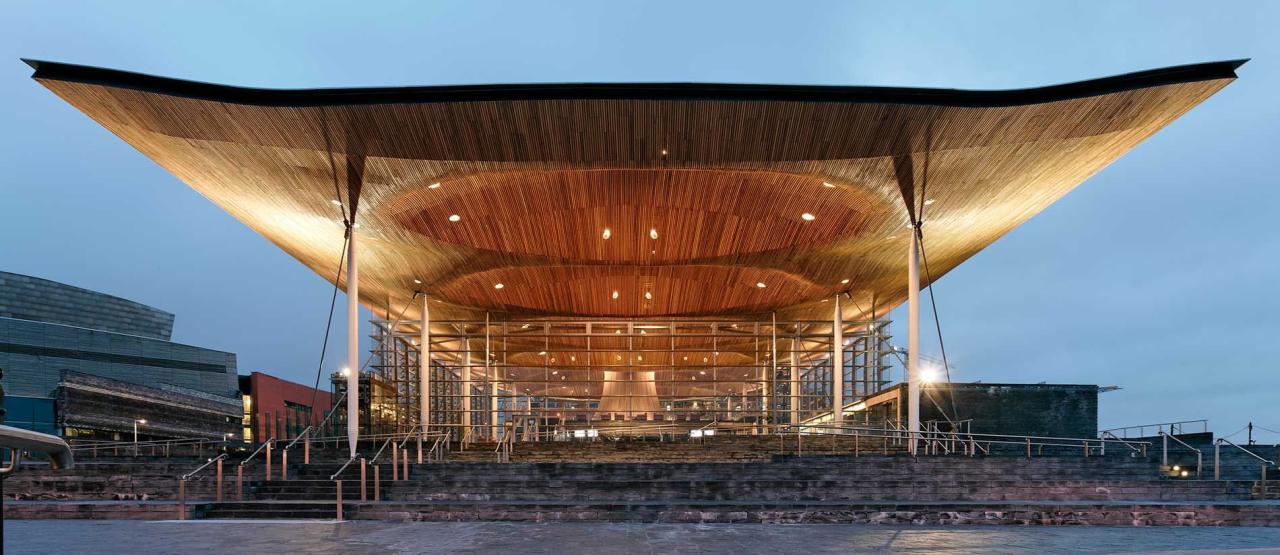
Natural lighting is a key element of the building’s design. The use of glass and strategic orientation maximizes daylight penetration, reducing the need for artificial lighting and creating a bright, open atmosphere inside.
Richard Rogers describes The Senedd as:
“More than just a parliament building. It is a symbol of Wales’ identity and our commitment to sustainability. By combining tradition with innovation, we have created a building that will inspire generations to come.”
The building’s design also emphasizes transparency and accessibility, reflecting democratic values. The public can observe parliamentary proceedings through a large, open gallery, and the building hosts exhibitions and events that engage the community.
Advanced technologies are integrated throughout The Senedd to enhance its functionality and efficiency. Building management systems monitor energy usage and environmental conditions, allowing for continual optimization of resources.
Conclusion
These five architectural marvels showcase how advanced technology is shaping the future of building design. From intelligent systems that create personalized work environments to innovative structures that redefine urban living, these buildings are at the forefront of sustainable and futuristic architecture.
By embracing cutting-edge technologies, architects and designers are creating spaces that are not only aesthetically remarkable but also environmentally responsible and user-centric. These buildings serve as inspirations for future developments, demonstrating how innovation can lead to better, more sustainable ways of living and working.
As technology continues to advance, we can expect to see even more groundbreaking designs that push the boundaries of what is possible in architecture. The integration of smart systems, renewable energy, and sustainable materials will be key factors in shaping the buildings of tomorrow.














